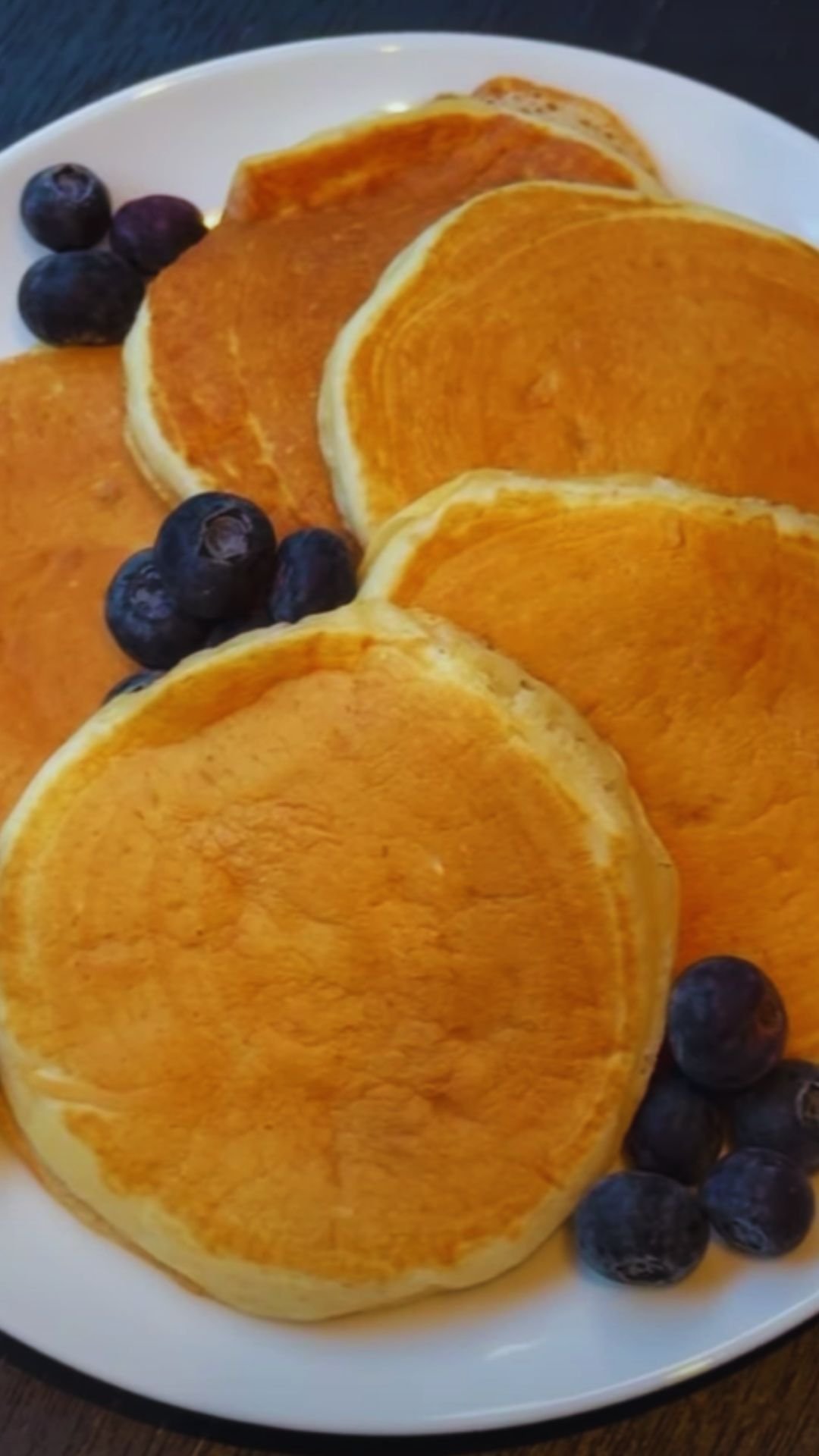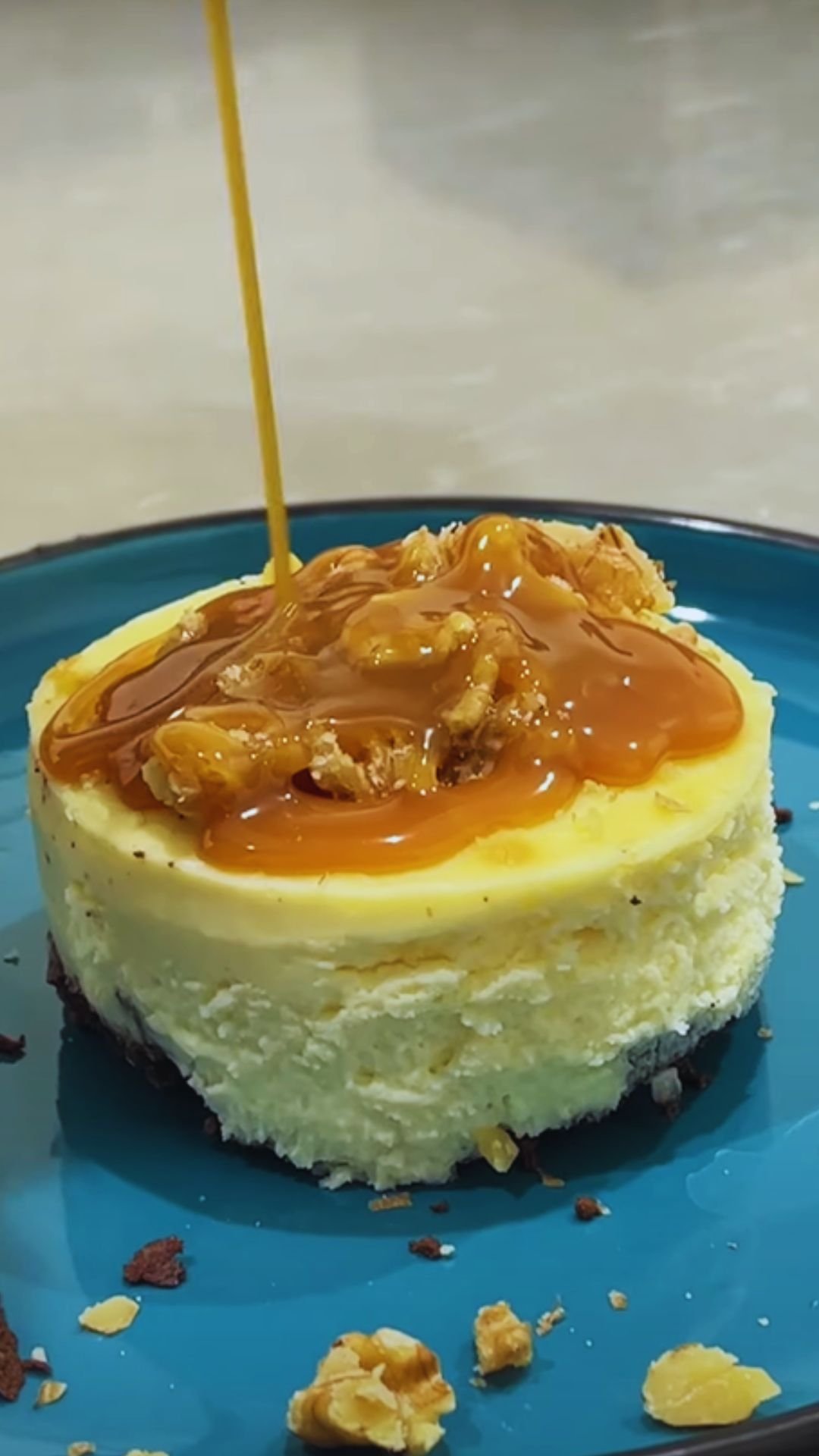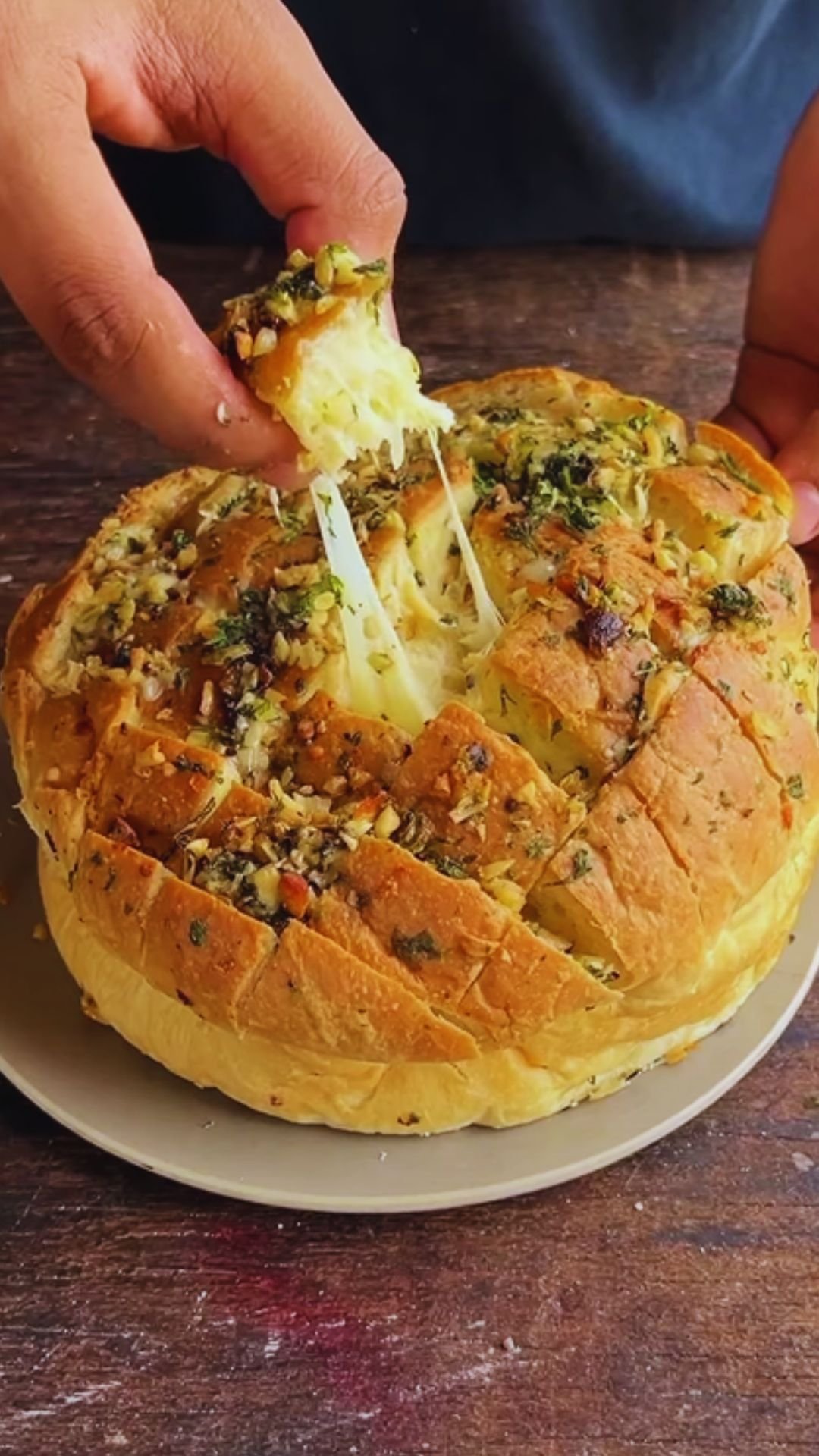There’s something magical about starting your day with a stack of warm, fluffy pancakes. The comforting aroma filling the kitchen, the sight of steam rising from a fresh batch, and that first bite of tender, pillowy goodness drizzled with maple syrup. But what if I told you that your favorite weekend breakfast could be transformed into a protein-packed, nutritious meal that you can enjoy any day of the week without the guilt? That’s exactly what these Greek yogurt pancakes offer.
As someone who’s tested countless pancake recipes over the years, I can confidently say that adding Greek yogurt to pancake batter is a game-changer. Not only does it boost the protein content significantly, but it also creates an incredibly tender texture that rivals even the most indulgent traditional pancakes.
Why Greek Yogurt Makes Better Pancakes
When I first started experimenting with Greek yogurt in my pancake batter, I was simply looking for ways to add more protein to my breakfast. What I discovered was so much more. The thick, creamy consistency and slight tanginess of Greek yogurt transforms ordinary pancake batter in several remarkable ways:
- Protein boost: A standard serving of these pancakes contains approximately 15-20 grams of protein, compared to just 5-7 grams in regular pancakes.
- Incredible moisture: The yogurt keeps the pancakes tender and prevents them from drying out.
- Perfect texture: These pancakes achieve that elusive balance of fluffy yet substantial.
- Subtle tang: The yogurt adds a pleasant flavor dimension that pairs beautifully with both sweet and savory toppings.
- Better nutrition: Lower in refined carbs and higher in calcium and probiotics than traditional pancakes.
I’ve shared this recipe with countless friends and family members, and it’s now become their go-to as well. The best part? You don’t need any special equipment or hard-to-find ingredients. Everything you need is probably already in your kitchen.
The Perfect Greek Yogurt Pancake Recipe
Ingredients
- 1 cup all-purpose flour
- 2 teaspoons baking powder
- ¼ teaspoon baking soda
- ½ teaspoon salt
- 1 tablespoon granulated sugar (optional)
- 1 cup Greek yogurt (plain, full-fat works best)
- ¾ cup milk
- 2 large eggs
- 2 tablespoons melted butter, plus more for cooking
- 1 teaspoon vanilla extract
- Optional mix-ins: blueberries, banana slices, chocolate chips, or lemon zest
Equipment
- Large mixing bowl
- Small mixing bowl
- Whisk
- ¼ cup measuring cup or ice cream scoop
- Non-stick skillet or griddle
- Spatula
- Serving plate
Step-by-Step Instructions
- Mix dry ingredients: In a large bowl, whisk together the flour, baking powder, baking soda, salt, and sugar (if using) until well combined.
- Combine wet ingredients: In a separate bowl, whisk together the Greek yogurt, milk, eggs, melted butter, and vanilla extract until smooth.
- Create the batter: Pour the wet ingredients into the dry ingredients and stir gently until just combined. Some small lumps are perfectly fine—overmixing will make your pancakes tough.
- Rest the batter: Let the batter rest for 5-10 minutes. This allows the leavening agents to activate and the flour to hydrate, resulting in fluffier pancakes.
- Heat the pan: Heat a non-stick skillet or griddle over medium heat. Add a small amount of butter and spread it evenly across the surface.
- Cook the pancakes: Use a ¼ cup measuring cup or ice cream scoop to pour batter onto the hot surface. If adding mix-ins like blueberries or banana slices, sprinkle them onto the wet batter now.
- Watch for bubbles: Cook until bubbles form on the surface and the edges start to look set, about 2-3 minutes.
- Flip with confidence: Use a spatula to carefully flip each pancake and cook for an additional 1-2 minutes on the other side, until golden brown.
- Keep warm: Transfer cooked pancakes to a plate and cover with a clean kitchen towel to keep warm while you cook the remaining batter.
- Serve immediately: Stack your pancakes high and serve with your favorite toppings.
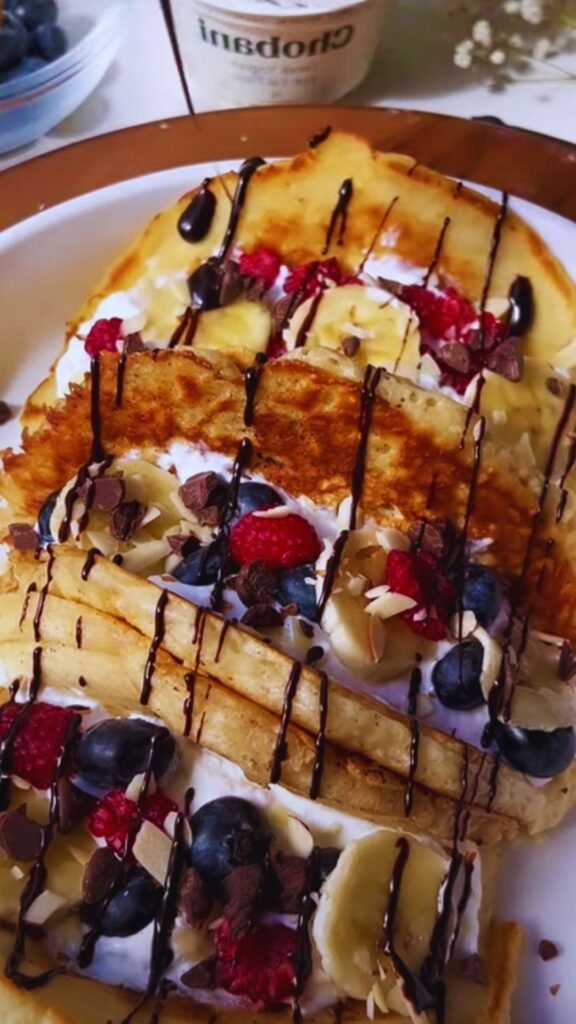
Nutritional Profile
Greek yogurt pancakes aren’t just delicious—they’re also significantly more nutritious than traditional pancakes. Here’s how they stack up:
| Nutrient | Greek Yogurt Pancakes (per serving) | Traditional Pancakes (per serving) |
|---|---|---|
| Calories | 320 | 380 |
| Protein | 18g | 7g |
| Carbohydrates | 36g | 53g |
| Fat | 12g | 14g |
| Fiber | 1g | 1g |
| Calcium | 240mg | 90mg |
| Probiotics | Yes | No |
| Sugar | 6g | 14g |
Note: Nutritional values are approximate and will vary based on specific ingredients used.
Troubleshooting Common Pancake Problems
Even experienced home cooks sometimes struggle with pancakes. Here are solutions to the most common issues I’ve encountered:
Pancakes too thick or dense
Problem: The batter is too thick and pancakes turn out heavy. Solution: Add 1-2 tablespoons of milk at a time until you reach a pourable but not runny consistency.
Pancakes too thin or flat
Problem: The pancakes spread too much and don’t rise properly. Solution: Add 1-2 tablespoons of flour to thicken the batter, or check if your baking powder is fresh.
Uneven cooking
Problem: Pancakes are golden on the outside but undercooked inside. Solution: Lower your heat and cook for a longer time to ensure even cooking throughout.
Sticking to the pan
Problem: Pancakes stick to the pan and fall apart when flipping. Solution: Make sure your pan is properly heated before adding batter, and don’t be shy with the butter.
Variations to Try
One of the things I love most about this recipe is its versatility. Here are some of my favorite variations that I’ve developed over time:
Lemon Blueberry Greek Yogurt Pancakes
Add 1 tablespoon of lemon zest to the batter and fold in 1 cup of fresh blueberries just before cooking. Top with a simple lemon glaze made from powdered sugar and fresh lemon juice.
Banana Cinnamon Greek Yogurt Pancakes
Add ½ teaspoon of cinnamon to the dry ingredients and fold in 1 mashed ripe banana into the wet ingredients. For extra indulgence, top with a few banana slices and a sprinkle of cinnamon sugar before flipping.
Chocolate Chip Greek Yogurt Pancakes
Add ½ cup of mini chocolate chips to the batter after mixing wet and dry ingredients. For a double chocolate version, add 2 tablespoons of cocoa powder to the dry ingredients as well.
Savory Greek Yogurt Pancakes
Omit the sugar and vanilla, and add ¼ cup chopped chives and 2 tablespoons of grated parmesan cheese to the batter. Serve with a dollop of Greek yogurt and smoked salmon or avocado.
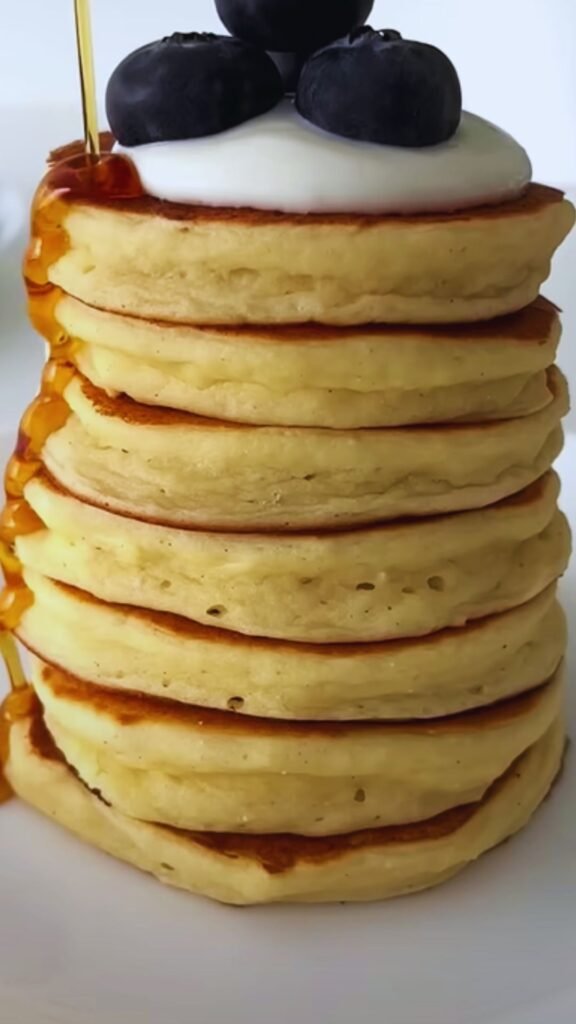
Make-Ahead and Storage Tips
Busy mornings are a reality for most of us, which is why I often prepare components of this recipe in advance:
Dry Mix Preparation
Combine all the dry ingredients in a mason jar or airtight container. This mix will keep for up to 3 months in the pantry. When you’re ready to make pancakes, just add the wet ingredients.
Batter Storage
If you’ve made the complete batter but don’t use it all, it can be stored in an airtight container in the refrigerator for up to 24 hours. The pancakes may not be quite as fluffy when cooked from refrigerated batter, but they’ll still be delicious.
Freezing Cooked Pancakes
Cooked pancakes freeze beautifully! Let them cool completely, then place parchment paper between each pancake and store in a freezer-safe bag or container for up to 3 months. To reheat:
- Microwave: 20-30 seconds for a stack of 2-3 pancakes
- Toaster: Pop them in the toaster for a slightly crisp exterior
- Oven: Wrap in foil and heat at 350°F (175°C) for 10 minutes
Topping Suggestions
The beauty of these protein-packed pancakes is that they’re a perfect canvas for both sweet and savory toppings. Here are some of my favorites:
Sweet Options
- Fresh berries and a drizzle of honey
- Sliced bananas and a swirl of almond butter
- Greek yogurt mixed with a touch of maple syrup
- Homemade fruit compote (simmer any fruit with a splash of water and sweetener)
- A dusting of powdered sugar and lemon zest
- Toasted nuts and a drizzle of maple syrup
Savory Options
- Avocado slices with a sprinkle of everything bagel seasoning
- A dollop of Greek yogurt with fresh herbs and a drizzle of olive oil
- Crumbled feta cheese and a touch of honey
- Smoked salmon and capers
- Sautéed mushrooms and spinach
The Science Behind Perfect Pancakes
Understanding a few basic principles of pancake science has dramatically improved my results:
Role of Leavening Agents
Baking powder and baking soda create the bubbles that make pancakes fluffy. In this recipe, we use both:
- Baking powder reacts with heat to create carbon dioxide bubbles
- Baking soda reacts with the acid in Greek yogurt for additional lift
Importance of Resting the Batter
Allowing the batter to rest for 5-10 minutes before cooking serves two important purposes:
- It gives the flour time to hydrate properly
- It allows the leavening agents to start working, creating a lighter texture
The Perfect Cooking Temperature
Medium heat is ideal for pancakes. It’s hot enough to create that lovely golden exterior while giving the inside time to cook through properly. If your pan is too hot, the outside will burn before the inside is done; too cool, and your pancakes will be pale and potentially soggy.
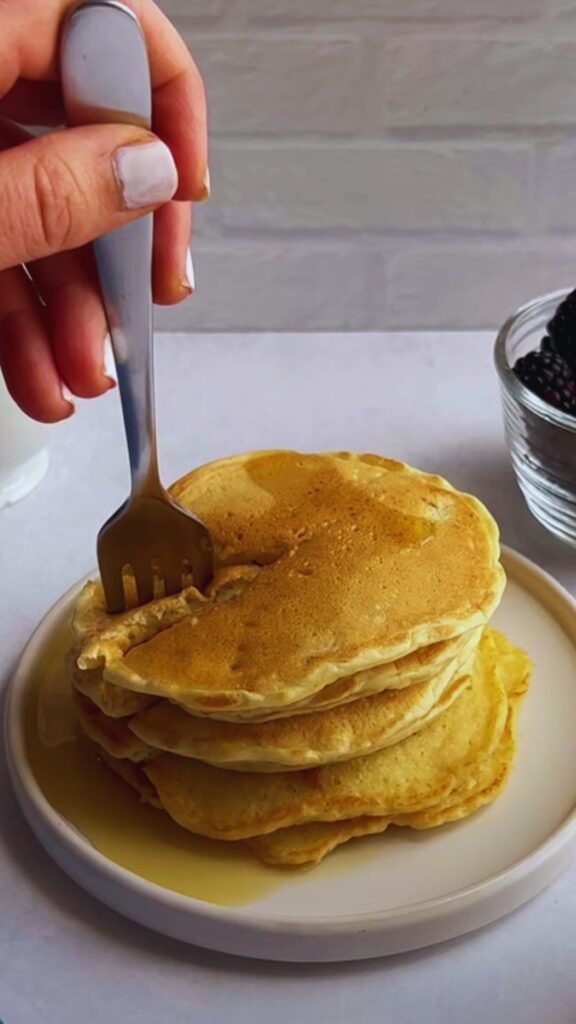
Health Benefits of Greek Yogurt Pancakes
As someone who tries to make nutritious food choices without sacrificing flavor, I love that these pancakes offer several health benefits:
Protein Content
The high protein content from the Greek yogurt helps keep you fuller longer and provides sustained energy throughout the morning. This makes these pancakes particularly good for active individuals or growing children.
Probiotics
Greek yogurt contains beneficial probiotics that support gut health. While some will be neutralized during cooking, studies suggest that a significant portion can survive and provide benefits.
Lower Sugar Option
By controlling the amount of sweetener in both the batter and toppings, these pancakes can be substantially lower in sugar than traditional pancake recipes or restaurant versions.
Calcium Boost
Greek yogurt is an excellent source of calcium, which is essential for bone health and various cellular functions in the body.
Frequently Asked Questions
Q: Can I use non-fat Greek yogurt instead of full-fat? Yes, you can use non-fat Greek yogurt, but your pancakes might be slightly less tender. If using non-fat yogurt, I recommend adding an extra tablespoon of melted butter to the batter.
Q: Are these pancakes gluten-free? The recipe as written contains gluten from the all-purpose flour. However, you can easily substitute a 1:1 gluten-free flour blend with excellent results. I’ve tested this with several brands and found that cup-for-cup gluten-free flour works wonderfully.
Q: Can I make these pancakes dairy-free? Yes! Substitute the Greek yogurt with dairy-free yogurt (coconut or almond-based work well), use your favorite plant milk, and replace the butter with coconut oil or a plant-based butter alternative.
Q: How can I increase the protein content even more? For an extra protein boost, you can add 1-2 tablespoons of your favorite unflavored or vanilla protein powder to the dry ingredients. Just be prepared to add a little extra milk if the batter becomes too thick.
Q: Can I make the batter the night before? While it’s not ideal (the leavening agents will lose some potency), you can mix the wet and dry ingredients separately and store them in the refrigerator overnight. Combine them in the morning just before cooking.
Q: Why did my pancakes turn out flat? This could be due to overmixing the batter (which develops gluten and prevents rising), inactive leavening agents (check if your baking powder is fresh), or not letting the batter rest before cooking.
Q: How do I know when to flip the pancakes? Look for bubbles forming on the surface of the pancake and edges that begin to look set. This usually takes about 2-3 minutes on medium heat. The edges should look slightly dry when it’s time to flip.
Why These Pancakes Have Become My Weekend Ritual
There’s something deeply satisfying about mastering a recipe that’s both delicious and nutritious. These Greek yogurt pancakes have become my weekend ritual—a way to slow down and savor the morning while still providing my body with quality nutrition.
I love watching friends and family enjoy these pancakes for the first time, often surprised that something so protein-rich can taste so indulgent. Children particularly love these pancakes, and parents appreciate that they’re getting a substantial breakfast rather than just empty calories.
Whether you’re cooking for yourself, your partner, or a whole family, these Greek yogurt pancakes are adaptable to any situation. They’re equally at home on a rushed weekday morning (especially if you’ve frozen some from a previous batch) or as the centerpiece of a leisurely weekend brunch spread.
I hope you’ll try these pancakes and experiment with making them your own by trying different mix-ins and toppings. Food is not just about nutrition—it’s about joy, creativity, and connecting with those we love. These pancakes deliver on all fronts.
Final Tips for Pancake Perfection
Before you head to the kitchen to try this recipe, here are my final tips for achieving pancake perfection:
- Use room temperature ingredients when possible, especially eggs and yogurt. Cold ingredients don’t combine as smoothly.
- Don’t fear the lumps in your batter. A few small lumps will give you fluffier pancakes than a perfectly smooth batter, which can become dense and tough.
- Flip only once. Each pancake should only be flipped a single time for the best texture. Repeated flipping can deflate them.
- Test your heat with a small amount of batter before committing to a full pancake. This saves batter and helps you get the temperature just right.
- Watch your thickness. If your batter is too thick, your pancakes may be undercooked in the middle. The perfect batter should be pourable but not runny.
These Greek yogurt pancakes have become my signature breakfast dish—the one friends request when they stay over and the recipe I’m most often asked to share. I hope they bring as much joy to your breakfast table as they have to mine!
Q&A Section
Q: How do Greek yogurt pancakes compare to regular pancakes in terms of texture? Greek yogurt pancakes are generally more tender and moist than regular pancakes. The acidity in the yogurt also reacts with the leavening agents to create an exceptionally fluffy texture. Many people find them less likely to become dry or tough than traditional pancakes.
Q: Can I make these pancakes with flavored Greek yogurt? Absolutely! Using flavored Greek yogurt can add an interesting dimension to your pancakes. For example, vanilla or honey Greek yogurt will add sweetness, while fruit-flavored varieties can infuse your pancakes with subtle fruit flavors. Just be aware that flavored yogurts contain added sugar, so you might want to reduce or eliminate the additional sugar in the recipe.
Q: What’s the best way to achieve consistent pancake sizes? For uniform pancakes, I recommend using a ¼ cup measuring cup or an ice cream scoop with a release mechanism. This ensures that each pancake receives the same amount of batter. Pour the batter from the same height each time to help control how much it spreads on the griddle.
Q: How can I tell if my baking powder is still active? To test if your baking powder is still active, place a teaspoon in a cup and add ¼ cup of boiling water. If it bubbles vigorously, it’s still good to use. If not, it’s time to replace it. Baking powder typically loses its potency after about 6-12 months, even when properly stored.
Q: Do I need to butter the pan between each batch of pancakes? I recommend applying a light coating of butter before each new batch. This ensures that your pancakes don’t stick and helps them develop that beautiful golden-brown color. You don’t need much—just enough to lightly coat the cooking surface.
Q: What’s the secret to getting that perfect golden color? The perfect golden color comes from a combination of the right heat (medium is ideal) and a small amount of butter on the cooking surface. The sugars in the batter caramelize slightly, creating that beautiful color. Adding a bit of sugar to the batter helps with browning too, even if you’re making a less sweet version.
Q: Can I make mini pancakes with this recipe? Yes! This batter works beautifully for mini pancakes or “silver dollar” pancakes. Simply use about 1-2 tablespoons of batter for each pancake. They’ll cook more quickly than full-sized pancakes, so keep a close eye on them and flip when the bubbles appear on the surface, usually after about 1-1.5 minutes.
Q: How do I prevent my pancakes from getting soggy when serving a crowd? Keep cooked pancakes warm in a single layer on a baking sheet in a 200°F (95°C) oven until ready to serve. Avoid stacking them until serving, as the steam can make them soggy. If you must stack them, place a piece of parchment paper between each pancake.

